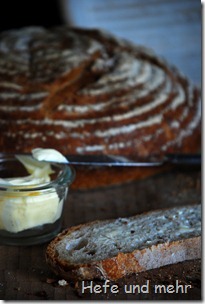 When you bake your own bread, you normally have to deal with leftover bread, too. When the bread become stale, I normally place it on top of the kitchen radiator and let them dry out completely. When they are dry, I put them in a food container and keep them for further use, like bribing our guinea pig (not a healthy treat, I know) or crushing them to bread crumbs. The bread crumbs I use regulary for cooking and baking. I like to put them into the filling of sweet pastries. Or I add them into a bread dough, replacing a part of the flour with the bread crumbs.
When you bake your own bread, you normally have to deal with leftover bread, too. When the bread become stale, I normally place it on top of the kitchen radiator and let them dry out completely. When they are dry, I put them in a food container and keep them for further use, like bribing our guinea pig (not a healthy treat, I know) or crushing them to bread crumbs. The bread crumbs I use regulary for cooking and baking. I like to put them into the filling of sweet pastries. Or I add them into a bread dough, replacing a part of the flour with the bread crumbs.
Lutz like to put old bread into preferments. I like this idea and vary his kind of preferment, so that its made out of bread crumbs completely. Together with some sourdough and a slow and long proof in the fridge, it adds a lot of flavour to the bread. Very delicious!
Wheat Bread with “old Bread”
Sourdough
- 220g flour Type 550
- 155g Water
- 25g Sourdough-Starter
Preferment made with old Bread
- 200g dried (Whole Wheat-)Bread, crushed into breadcrumbs
- 400g Water
- 1g fresh yeast
Dough
- Sourdough
- Preferment
- 1100g flour Type 550
- 650g Water
- 22 g Salt
- 5g fresh yeast
In the morning mix water, flour and starter for the sourdough and ferment for about 10 hours at 25°C.
For the bread ferment crush the bread to fine crumbs, mix crumbs with yeast and water. Ferment for about 10 hours at 25°C.
Mix all ingredients for the dough and knead it for about 5 min at low speed, then 8 min on high speed until medium gluten development.
Ferment for 1,5 hours. Fold the dough one time during this time.
Form three breads and place them in brotforms.
Proof overnight in the fridge.
The next morning heat the baking stone at 250°C.
Bake the breads for 45 min with steam.
I sent this entry to Yeastspotting, Susans weekly showcase of yeast baked good.
Deutsch



Hallo Stefanie,
Heute mit Dinkel 630 und 2 Tl. Flohsamenschale gebacken, klasse Rezept zur Semmelbrösel Verwertung.
Das Altbrotkörbchen war wieder voll, dein Blog ist immer eine gute Rezept Quelle.
Dir einen schönen Sommer.
Bin grad beim Stöbern hier gelandet 🙂 Du schreibst, dass du beim Brotbacken einen Teil des Mehls durch Semmelbrösel ersetzt. Wie groß ist dieser Teil in etwa? Und bleibt das restliche Rezept bestehen oder müssen Mengen angepasst werden – Wasser oder Hefe z. B. Ich selbst backe zeitlich bedingt mit einem Brotbackautomaten. Vielen Dank für deine Antwort.
@Corina: Du kannst 10-15% des Mehls mit Semmelbröseln ersetzen. Am meisten Geschmack gibt es, wenn du die Semmelbrösel als Vorteig ansetzt. Semmelbrösel können etwas mehr Wasser binden, darum würde ich die Wassermenge um 5% erhöhen.
danke für dieAntwort = Aufklärung. am Wochenende werde ich dieses Brot versuchen.
liebe Grüße aus Österreich
von katrili
durch Zufall bin ich auf dieser Seite gelandet, koche und Backe sehr gerne.
finde hochinteresant, die Verwendung von altem Brot bezw. die Brösel davon.
doch bitte,
bei der Zutatenliste 1g Hefe 5g Hefe – ist das Trockenhefe ?
ohne Mikrowelle bei Raumthemperatur ?
Mehl 550 …Deutschland hat andere Nummerierung – könnte das auf Östereichisch übersetzt Mehl 700 sein also glattes Mehl???
was bezeichnen sie als “schwaden”
ev. heißes Wasser ins Rohr zu geben? entschuldigung alle diese Fragen, bin demnach Anfänger ! danke im Voraus für die Antwort
@Katrili: Du musst dich doch nicht für die Fragen entschuldigen, frag, bis dir alles klar ist!
Ich verwende immer frische Hefe, die Mengen sind zwar klein, aber da ja auch noch Sauerteig zum Teig hinzukommt braucht man nicht mehr. Mit entsprechend langer Gehzeit kann man sogar ohne Sauerteig und mit noch weniger Hefe ein Brot backen.
Wenn möglich solltest du den Vorteig bei warmer Umgebungstemperatur (etwa 25°C) gehen lassen, z.B. in der Nähe der Heizung.
Type 550 Mehl sollte dem W700 entsprechen und schwaden bedeutet mit Dampf backen. Das kann man mit heißen Wasser oder Eiswürfeln, die man in den Ofen wirft, erreichen. Schau mal hier in das Rezept, da habe ich die Eiswürfel-Methode beschrieben.
Und wenn du magst, bist du auch herzlich dazu eingeladen, an meinem Geburtstags-Blogevent teilzunehmen, dazu braucht es nämlich nichtmal einen Blog 😉
I live in USA……looking for white Weizenbrot bread……….will I have to make it, or is there somewhere to purchase??
@Laura: I’m living in Germany so I can not give advices where to find good bread in the USA. But baking your own Bread is not so complicated and a lot of fun 🙂
i love this re-using of old bread. It brings a wonderful depth of flavor to the new dough. Your picture is stunning too! It could be in a magazine!!!
Im Text ist Brühstück erwähnt. Woraus wird dieser denn gemacht?
@Ameise: Da hat sich ein Brühstück reingemogelt, dass da gar nicht hin sollte. Danke für den Hinweis!
Pingback: Hefe und mehr » Blog Archive » Baguette mit “Altem Brot”, 3/4 Sponge und kalter Autolyse
Schöne Idee – ich hab’ da mal ‘ne Frage.
Kommt das Brot direkt aus dem Kühlschrank auf den Schieber und in den Ofen oder lässt man ihm erst Zeit Raumtemperatur anzunehmen?
@Henri: Ich schieße die Brote direkt ein. Ich konnte beim Backen bisher keinen Unterschied zwischen kühlschrank-kalt und Raumtemperatur feststellen.